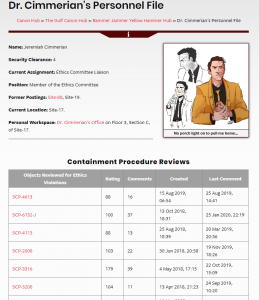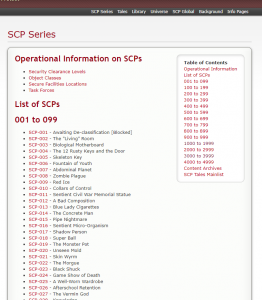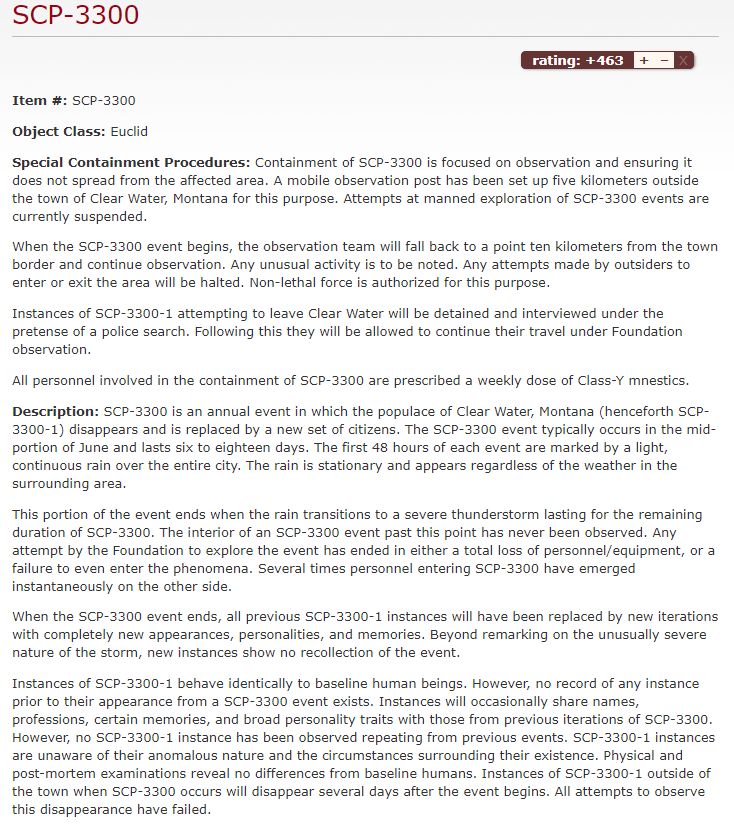Website Content
The SCP Wiki serves an audience who is looking for specific sub-genre of creepypasta (scary stories): a subgenre that the SCP Wiki itself has arguably pioneered and which was discussed in the Who’s Behind The Site portion of this essay.
Nearly all content on the SCP Wiki is generated by registered users and takes the form of either a report-style article — the most popular form of content on the wiki, which describe the qualities and containment procedures for various anomalous objects and entities using a dry and pseudo-scientific formula — and so-called “Tales” which take place in the same fictional universe as the report-style articles, but are more freeform — and thus aren’t held to the same standard of upholding the site’s facade as a database of scientific reports.
The Facade / Anonymity
When analyzing a web-page it’s typically a good idea to ask one’s self if the website in question is representing itself honestly. In the case of the SCP Wiki, that answer is a resounding no. The SCP Wiki is, in fact, purposefully deceptive about its purpose from the outset: The Wiki it presents itself as an actual database belonging to a pseudo-governmental shadow organization¹.

A little digging around — or common sense — however, will reveal that this is actually just a facade built to enhance the atmosphere of the website and the articles it contains. It is essentially a form of role-playing between the site staff, site authors, and readers.

This facade notably does mean that authors on the site are not easily identifiable. In order to maintain a sense that the articles on the site are intended for the eyes of researchers within the fictional SCP Foundation — and not for a public-facing website where accreditation is important — SCP Articles never directly identify their authors.
It is possible, however, to tie an author to a particular SCP article by visiting the Authors pages, on which registered users can make Bio for themselves². Popular writers will usually identify the SCPs they have worked on — some in a more cryptic fashion than others — but ultimately what goes on an author’s page is at their discretion.
Content Quality and Currentness
The quality of user-generated content is a common concern for user-generated wiki pages. In the case of the SCP Wiki, user-generated content is regulated with remarkable efficiency through user-powered a rating tool that will be explored further in the Website Functionality portion of the essay. Sufficed to say, the standards of what makes an article “quality” are primarily dictated by the community rather than the website staff, and very often these standards are shown to be quite high. Articles that do not meet the community’s standards for quality or canonicity are downvoted and deleted to make room for new articles.
 Speaking of deleted articles, it is worth noting that articles are not ordered strictly in terms of recency. Each and every SCP Article, rather, is assigned a number, for instance, “SCP-173,” that serves not only to organize the Article among its peers — in an intentionally arbitrary order — but also to give the subject of the article a serialized and dispassionate “official” name. When authors write a new article, they are free to choose any SCP number that isn’t currently occupied by another article. These articles are then organized by into so-called “series” of 1000 articles, with each article in the series being organized in sequential order by its SCP number.
Speaking of deleted articles, it is worth noting that articles are not ordered strictly in terms of recency. Each and every SCP Article, rather, is assigned a number, for instance, “SCP-173,” that serves not only to organize the Article among its peers — in an intentionally arbitrary order — but also to give the subject of the article a serialized and dispassionate “official” name. When authors write a new article, they are free to choose any SCP number that isn’t currently occupied by another article. These articles are then organized by into so-called “series” of 1000 articles, with each article in the series being organized in sequential order by its SCP number.
The deletion of low-quality articles is imperative for allowing new articles to be posted, as only a limited number of slots are available, with the website staff only occasionally adding new banks of 1000 blanks slots in the form of a new Series. The English version of the SCP Wiki began with only Series I and has thus far expanded its catalog all the way to Series V.
The Formula
SCP Articles — as opposed to SCP Tales — always follow a specific formula. This formula is not only simple, but is part and parcel to how the SCP Wiki has managed to carve out its own, very successful, sub-genre in the creepypasta “market.”

Each article begins with an Item Number to identify the subject of the article. The item number is followed by the subject of the article’s Object Class: a classification used to convey how difficult the object and its anomalous properties are to contain, and typically how dangerous the object is.
Safe represents an object that can be reliably and permanently contained and/or poses next to no threat on its own.
Euclid represents an object that poses a significant risk to those exposed to it, and that poses a significant challenge to contain.
Keter represents an object that if left uncontained poses an imminent threat to all human-kind. Keter objects are typically purported to be almost impossible to permanently contain.
Object class is always followed by the objects Special Containment Procedures which describe the strictures that the SCP Foundation has found must be followed in order to keep the object contained. Special Containment Procedures are then followed by the object’s Description, which describes the object’s properties in dispassionate, vaguely scientific language befitting of a formal report.
Some Articles also feature an Addendum which serves as a collection of fictional updates to the objects record. These addendums often provide additional context in the form of transcripts, either of interviews with the object in question, or of experiments conducted on the object.
Essay Table of Contents:
- http://www.scp-wiki.net/
- http://www.scp-wiki.net/authors-pages